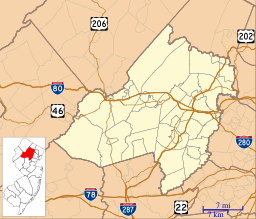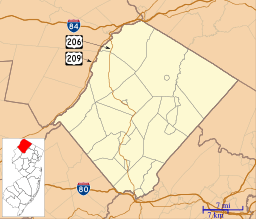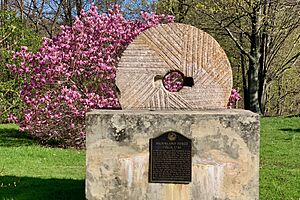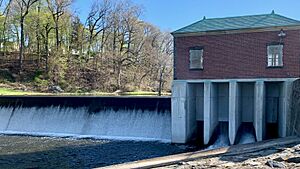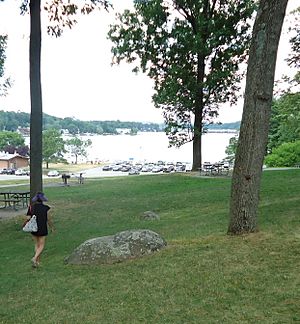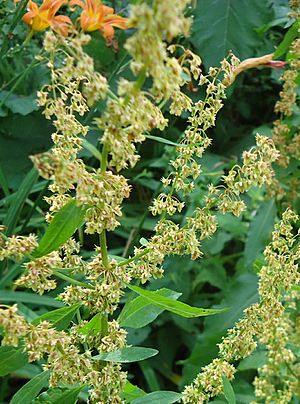Lake Hopatcong facts for kids
Quick facts for kids Lake Hopatcong |
|
|---|---|

At sunset, seen from Bertrand Island
|
|
| Location | Morris / Sussex counties, New Jersey, United States |
| Coordinates | 40°57′N 74°38′W / 40.950°N 74.633°W |
| Type | natural lake, reservoir |
| Primary inflows | Weldon Brook, Unnamed Streams, natural spring |
| Primary outflows | Musconetcong River |
| Basin countries | United States |
| Max. length | 9 mi (14 km) |
| Max. width | 800 ft (240 m) to 1 mi (1.6 km) |
| Surface area | 4 sq mi (10 km2) |
| Max. depth | 50 ft (15 m) |
| Shore length1 | Over 50 mi (80 km) |
| Surface elevation | 950 ft (290 m) |
| Islands | Bertrand Island/Halsey Island/Raccoon Island/Liffy Island |
| Settlements | Mount Arlington/Hopatcong/Jefferson/Roxbury Township |
| 1 Shore length is not a well-defined measure. | |
Lake Hopatcong is the biggest freshwater lake in New Jersey, USA. It covers about 4 square miles (10 square kilometers). It's located about 30 miles (48 km) from the Delaware River and 40 miles (64 km) from Manhattan, New York City. The lake sits on the border between Sussex and Morris counties. This area is part of New Jersey's northern highlands.
Lake Hopatcong was created by building a dam. This dam flooded two smaller ponds, called the Great Pond and Little Pond. It also flooded part of the Musconetcong River, which is the lake's natural outlet. Long ago, it was a popular vacation spot for people from New York. Today, it's mostly surrounded by homes.
Contents
What's in a Name?
The exact meaning of "Hopatcong" isn't fully known. Many people believe it comes from the Lenape Indian language. It might mean "stone water" or "stone over water." Some language experts think it comes from the Lenape word hapakonoesson, meaning "pipe stone." Another idea is that it came from Huppakong, meaning "honey waters of many coves." This last idea was likely made up in the early 1900s to attract tourists.
Before the late 1700s, Lake Hopatcong had different names. These included Great Pond and Little Pond (before they joined). It was also called Sandhay Sea around 1648. In the mid-1700s, it was Brookland Pond. By 1769, it was known as Musconetcong Pond.
How Lake Hopatcong Formed
Before the last ice age, the water in the Hopatcong area flowed into the Raritan River. A large glacier then moved through the New Jersey Highlands. This glacier created a long ridge of rock and dirt called a moraine. This moraine changed the water flow, sending it into the Musconetcong River instead. The glacier also left behind two ponds, which were about 2 miles (3.2 km) apart.
In the early 1700s, the Great Pond was located between Henderson Bay and what is now Hopatcong State Park. Little Pond was a smaller body of water south of Woodport. These two lakes were first dammed in 1750. By 1831, Lake Hopatcong had been flooded to almost its current size and shape.
Lake Hopatcong's History
Early Native American Life
The Lenape Indians discovered the Lake Hopatcong area about 12,000 years ago. They settled near the Great Pond and Little Pond. These ponds offered plenty of fish. The nearby forests had lots of animals for hunting. The waters became very important to the traditions of the matrilineal clans of these Native American people.
Colonial Times and Changes
European explorers started looking at the Great and Little Ponds in the 1600s. Between 1750 and 1764, a dam was built on the Musconetcong River. This dam was for the Brookland Forge and a mill. It was built where the river flows out of the lake, which is now the area of Hopatcong State Park. This dam raised the water level by about 6 feet (1.8 meters). This joined the Great and Little Ponds into one larger lake. By this time, most of the local Lenape people had either died from diseases or moved away.
After the American Revolution, not much development happened near Lake Hopatcong. This was because the area was very mountainous.
The Industrial Age
Lake Hopatcong is more than 900 feet (274 meters) above sea level. This high elevation made it a perfect natural water source for the Morris Canal. This canal connected the Delaware River to New York Harbor. In 1831, the Morris Canal Company bought the Brookland Forge site. They replaced the old dam with their own. Their goal was to use the lake's water to supply the Morris Canal. This canal would link Phillipsburg to Newark. The new dam raised the water level about 12 feet (3.7 meters) higher than the original Great Pond. This caused the Great Pond to connect with Little Pond, forming the Lake Hopatcong we know today.
When the lake flooded and became one large body of water, it changed the area's geography. Halsey Island and Raccoon Island became true islands, separated from the mainland. Bertrand Island and Liffy Island became peninsulas (land almost surrounded by water). Other changes included the creation of Prospect Point. The River Styx in Hopatcong flowed backward, creating an inlet. King Cove and the south end of the lake near Landing also formed.
In the 1850s, the Morris and Essex Railroad was the first train line to reach the southern end of Lake Hopatcong. In the 1860s, the Ogden Mine Railroad used Nolan's Point. They transferred ore from northern New Jersey mines onto canal boats there. Railroads and canals were the main ways to move coal, iron, and zinc across New Jersey in the 1860s. In 1866, over 880,000 long tons (894,000 metric tons) of goods were moved on the canal.
A Popular Resort
In 1882, passenger train service came to Lake Hopatcong. The Central Railroad of New Jersey built a line that ended at Nolan's Point. This made the lake a very popular summer resort.
Many hotels were built to support the growing tourism. One was the fancy Breslin Hotel in Van Every Cove in Mount Arlington. It had 250 rooms and electricity. During the busy summer season, the lake was so popular that it was hard to find hotel rooms. Some visitors even ended up camping near the lake.
Different fun activities popped up around the lake. Bertrand Island Amusement Park was open in late spring, summer, and early fall. The island also hosted beauty pageants. An unofficial 1934 Miss America contest was held there. The Lake Hopatcong Yacht Club, built in 1910 on Bertrand Island, is still a famous landmark.
Lake Hopatcong also hosted several important chess tournaments in the 1920s. This included the Ninth American Chess Congress in 1923, won by Frank Marshall and Abraham Kupchik. Another tournament in 1926 was won by world champion José Raúl Capablanca.
Lake Hopatcong was very lively in the 1920s. Many famous people owned homes there. These included Vaudeville stars like Joe Cook and Owen McGiveney. Actress Lotta Crabtree and inventor Hudson Maxim also owned property. Their presence attracted many other famous visitors. These included Babe Ruth, Bud Abbott, Bert Lahr, and Milton Berle.
Becoming a Residential Area
The Great Depression in the 1930s and 1940s hit tourism and businesses near the lake hard. They started to decline. In the 1940s and 1950s, people started building permanent homes, including small bungalows. Most of the modern homes around the lake were built in the 1960s and 1970s.
Recent Times: 21st Century
The 2000 Flood
From August 11–14, 2000, over 14 inches (36 cm) of rain fell in a small area of northern New Jersey. Some estimates showed up to 15 inches (38 cm) of rain. A very strong thunderstorm on August 12 dropped so much rain in six hours that it was considered a "1,000-year event."
The water levels in Lake Hopatcong and the Musconetcong River reached their highest points ever recorded. These levels were higher than what's expected in a "100-year flood." Lake Hopatcong suffered damage from the flooding, especially the Great Cove area at Nolan's Point.
Lowering the Lake (Drawdown)
Every five years, after Labor Day, the New Jersey Department of Environmental Protection (DEP) lowers the lake's water level by 5 feet (1.5 meters). This is part of their water management plan. It allows them to check the dam, and property owners can repair their lakeside structures. It also helps control water plants and remove silt from around the lake.
In late 2008 and early 2009, the DEP left the dam open too long. This caused the water level to drop almost a foot (0.3 meters) below the usual drawdown level. Some residents and business owners were upset and took legal action. They claimed the DEP released too much water.
In May 2009, some boat races were postponed because of the low water. However, a lot of rain in June brought the lake back to its normal level. This happened just in time for summer and boating season.
In July 2014, there were reports of a 15-foot (4.6 meters) boa constrictor seen in the lake. By August, officials mostly thought it was a myth or a joke. One report said these rumors caused a 10% drop in tourism to the lake that summer.
Lake Hopatcong Today
Today, Lake Hopatcong is mostly a residential lake. This means most of the shoreline has private homes. There are only a few public places to access the lake. These include Hopatcong State Park and Lee's County Park Marina.
Unlike most lakes in New Jersey, Lake Hopatcong has restaurants and bars you can reach directly by boat. Popular places to visit on the lake include Hopatcong State Park, the Lake Hopatcong Historical Museum, and the Lake Hopatcong Yacht Club.
In November 2005, the EPA gave the Lake Hopatcong Commission a grant of $745,000. This money was to help improve the water quality and stop too much phosphorus from entering the lake.
Managing the Lake
Lake Hopatcong is shared by two counties: Sussex and Morris. It's also part of four towns: Mount Arlington, Hopatcong, Jefferson Township, and Roxbury Township.
Years ago, a state-funded group called the Lake Hopatcong Regional Planning Board helped manage the lake. They made suggestions to the state. This board had members from each town, county, and the state. But it wasn't very effective. Weeds grew a lot, water quality got worse, and fun activities suffered.
In January 2001, Governor of New Jersey Christie Whitman signed a law to create the Lake Hopatcong Commission. This is a state-funded group with a yearly budget to keep the lake healthy and protect it. The commission has 11 members. These include a representative from each of the two counties and four towns. There are also five state members, including one from the Department of Environmental Protection. The governor chooses the chairperson and two other public members.
However, the commission's budget has been cut every year since it started. It has mostly only provided services like removing weeds. In 2012, the state took over weed removal through Hopatcong State Park. The Lake Hopatcong Commission didn't get state funding for 2013. Now, it runs only on grants. The commission administrator was laid off in December 2012. Jefferson Township now handles the administrative tasks for grants.
Lake Wildlife
Lake Hopatcong has more different kinds of gamefish than almost any other waterway in New Jersey. Only the Delaware River might have more.
Every spring, the New Jersey Division of Fish and Wildlife adds rainbow trout to the lake. In the past, they also added brook and brown trout. However, these trout usually don't survive the summer. This is because the lake doesn't have enough cold, deep spots with lots of oxygen.
Many other fish live in the lake. These include largemouth bass, smallmouth bass, sunfish, yellow and white perch, rock bass, bluegill, crappie, chain pickerel, channel catfish, bullhead, and carp. Eels have also been caught. In recent decades, hybrid striped bass, walleye, and muskellunge have been added. These fish are now doing well. Catfish are also added sometimes. The main food source for these fish is the many alewife herring. These small fish are the base of the lake's fish food chain.


